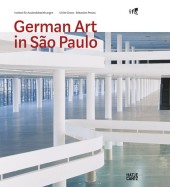 Neuerscheinungen 2013Stand: 2020-01-07 |
Schnellsuche
ISBN/Stichwort/Autor
|
Herderstraße 10
10625 Berlin
Tel.: 030 315 714 16
Fax 030 315 714 14
info@buchspektrum.de |

Ulrike Groos, Institut für Auslandsbeziehung, Sebastian Preuss
(Beteiligte)
German Art in SÆo Paulo
Deutsche Kunst auf der Biennale 1951-2012
Herausgegeben von Groos, Ulrike; Preuss, Sebastian
2013. 336 S. 404 Abb. 290 mm
Verlag/Jahr: HATJE CANTZ VERLAG 2013
ISBN: 3-7757-3694-8 (3775736948)
Neue ISBN: 978-3-7757-3694-7 (9783775736947)
Preis und Lieferzeit: Bitte klicken
Die Geschichte der deutschen Beiträge auf der Biennale von SÆo Paulo
Ein Industrieller gründete 1951 die Biennale in SÆo Paulo, die zweitälteste Kunstschau ihrer Art. Das erklärte Vorbild war von Beginn an die Mutter aller Biennalen in Venedig. Wie dort suchten die teilnehmenden Länder die Künstler aus und sandten sie auf eigene Kosten nach Brasilien. Die junge Bundesrepublik räumte der Weltkunstausstellung im fernen SÆo Paulo stets große Bedeutung ein. Seit 1977 war auch die DDR vertreten, wenn auch mit einem sehr viel bescheideneren Auftritt.
Das reich bebilderte Buch dokumentiert erstmals alle deutschen Beiträge in den bislang 30 Biennalen und beleuchtet sie im Kontext der Nachkriegskunstgeschichte und der Kulturpolitik. Archivstudien in SÆo Paulo, Berlin und Stuttgart förderten eine Fülle an nie veröffentlichten Dokumenten und Fotos zutage. Eigene Essays schildern die Gründung und die Geschichte der Biennale, die eng mit dem Schicksal der brasilianischen Moderne verbunden ist.
In 1951 the Italian-Brazilian industrialist Ciccillo Matarazzo founded the SÆo Paulo Biennial, the second-oldest art show of its kind. From the start, it was said that the shows role model was the mother of all biennials in Venice. As is the case there, the participating countries choose artists to represent them and send them to Brazil at the countries expense. The young Federal Republic of Germany always attributed great importance to the global art exhibition in far-away SÆo Paulo. The German Democratic Republic was also represented from 1977 onward, although with far more modest presentations.This richly illustrated book is the first to document all of the German contributions to the thirty biennials that have taken place up to now, and examines them in the context of post-war history and cultural politics. Studies of archives in SÆo Paulo, Berlin, and Stuttgart exhumed a cornucopia of previously unpublished documents and photographs. A number of essays describe the founding and the history of the biennial, which is closely associated with the fate of Brazilian Modernism.


